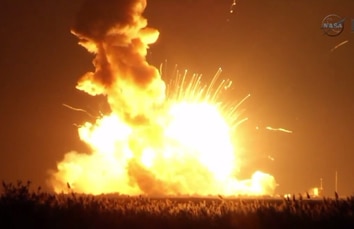Create a free profile to get unlimited access to exclusive videos, sweepstakes, and more!
BREAKING: Antares Rocket Explodes on Takeoff

Update, Oct. 29, 2014 at 14:45 UTC: There's some good news today: A Russian Soyuz rocket successfully launched this morning with supplies for the station, its Progress vehicle docking with ISS six hours later.
Update, Oct. 29, 2014 at 01:30 UTC: A NASA press conference was held a few hours after the explosion; here's a rundown. They told people not to pick up any debris they might find near the launch site, because it might be dangerous. The launch pad was damaged by the explosion, but it's not clear yet how badly (night fell around the time of launch, so it's dark in the area). As expected, they won't comment on the possible cause of the accident but did say the astronauts on ISS are in no danger; there is a Progress launch with supplies in a few hours, and a SpaceX Dragon resupply mission launch in a few weeks. They have several months of supplies on board in any case. The full cost of the rocket and payload was about $200 million. The next step is to analyze the data from telemetry, cameras on the ground, and the debris. Incidentally, they did say the flight safety officer did hit the detonate button after the initial failure, but it's not clear to me just when. They haven't released the exact timeline, so we won't know the precise timing of what happened when until that's released. Orbital Science Corp. has expressed profound regret that they couldn't complete their mission but vows to find out what happened, fix it, and fly again.
Fourteen seconds after launch tonight, the Orbital Sciences Corp.’s Antares rocket exploded. It’s not yet known why.
First: This was an uncrewed vehicle; no people were on board (and as I write this there are no reports of injuries). It was loaded with supplies and experiments for the International Space Station, and was Orbital's third such resupply mission.
As you can see, just seconds after launch there was something odd that happened in the first stage; there was a bright flare, then the bottom of the rocket exploded. As launch expert Jonathan McDowell notes, the first stage is built by the Ukranian company Yuzhnoe and uses Aerojet AJ-26 engines which are Russian NK-33 engines. These are very old engines (built in the 1960s and 70s) that are refurbished. While it’s not known if these were the cause of the explosion, I suspect they'll be very carefully scrutinized in the investigation. A recent test of one engine ended in failure.
Update, Oct. 28, 2014 at 22:30 UTC: Let me be clear: We don't know what caused this failure, and the engines are one of many possibilities. I am not pointing fingers, and I won't speculate beyond this. I changed the phrasing in the paragraph above to make this more clear.
Update, Oct. 29, 2014 at 01:00 UTC: More dramatic video is showing up, one taken from the press area a few kilometers away, as well as from an airplane flying near the launch site. I've embedded them below.
Tomorrow, a Russian Progress vehicle will be launched to ISS with more supplies. I don’t think the astronauts on board the station are in any trouble, but I suspect this may impact the November launch of three more astronauts to ISS as part of Expedition 42.
Update, Oct 28, 2014 at 22:40 UTC: NASA has a list of the Cygnus spacecraft payload on the Antares rocket. It includes food, hardware, and quite a few student experiments involving microgravity. Thanks to Katie Mack for the link.
This is all we know right now. I’ll post updates here as I find out more information, and you can go to the NASA OSC page as well.
My sincere and heartfelt condolences to everyone involved with this mission. Losing a vehicle, even an uncrewed one, is devastating. I hope the investigation quickly reveals the issue so that this can be fixed soon, and launches can resume.


























